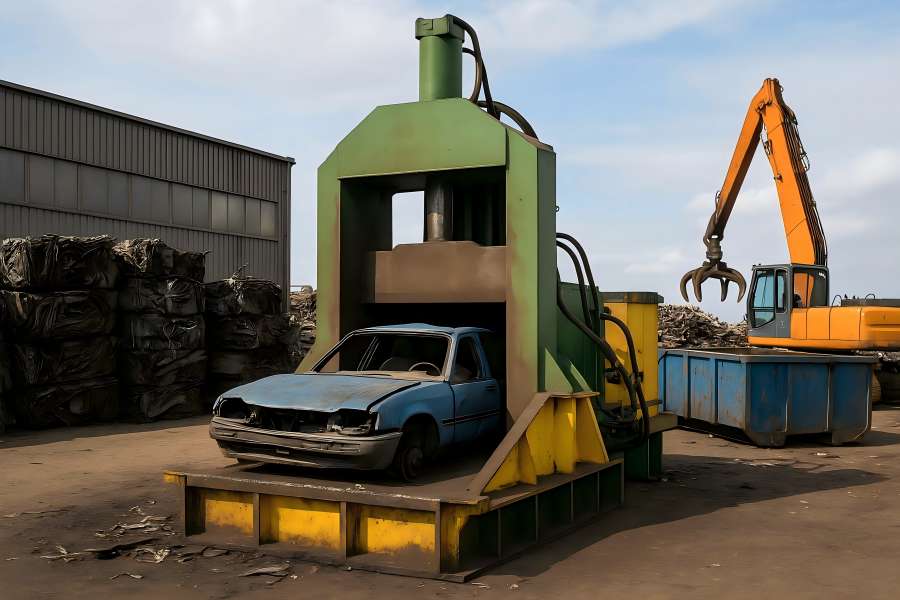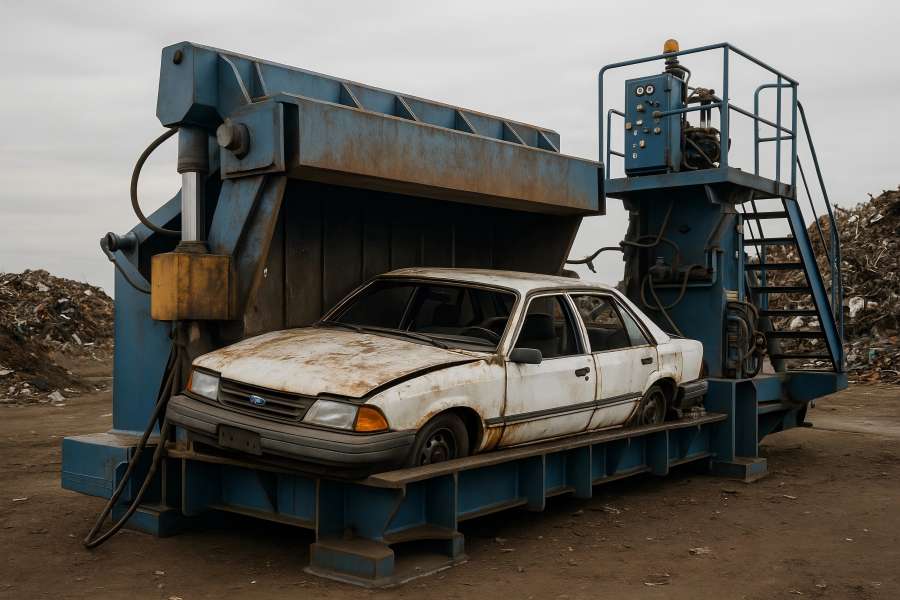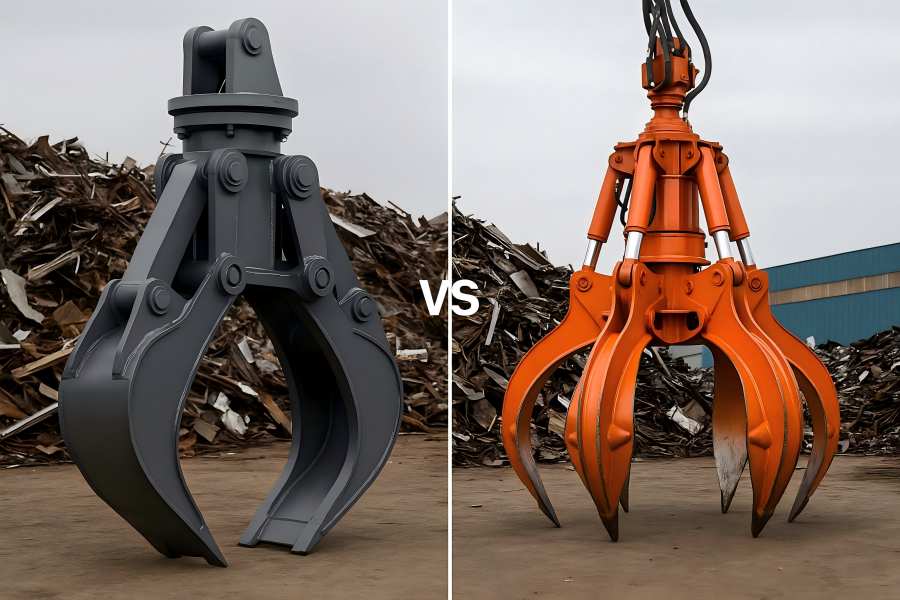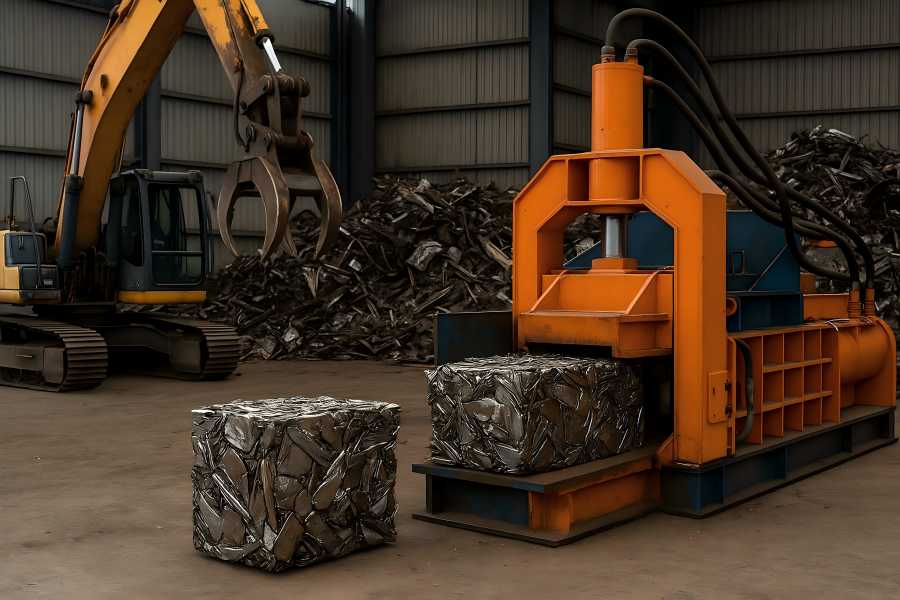Investing in a car compactor is not just about purchasing heavy equipment; it’s about transforming operational efficiency, reducing waste logistics, and maximizing material recovery. But for many recycling yards, auto dismantlers, and waste-processing centers, the real question is simple: Does the compactor pay for itself?
Understanding the return on investment (ROI) involves more than comparing purchase price and scrap output—it requires analyzing cost, maintenance, and productivity as interconnected elements of financial performance.
Understanding the Function and Role of Car Compactors
A car compactor—sometimes referred to as a car crusher, auto baler, or scrap vehicle press—is designed to compress end-of-life vehicles into dense, transportable units. Its core value lies in volume reduction and material densification, enabling recyclers to handle large quantities of scrap efficiently.
In a typical auto-recycling flow, vehicles are drained of fluids, depolluted, stripped of valuable parts, and then crushed or compacted. The compacted blocks are easier to store, load, and ship to shredders or smelters.
Car compactors, therefore, act as a financial hinge point—they affect logistics, labor efficiency, facility space, and throughput. A well-chosen machine can yield measurable cost savings and productivity improvements within months of deployment.
Cost Components that Shape ROI
Capital Investment
The purchase price of a car compactor varies widely depending on size, compression force, mobility, and automation level. Stationary hydraulic compactors for car shells can range from $200,000 to over $1.5 million. Mobile units add chassis and drive system costs but reduce transport setup expenses.
Capital investment also includes:
- Engineering design and customization
- Site preparation (concrete pads, foundations)
- Electrical or hydraulic infrastructure
- Control systems and safety interlocks
- Operator training and commissioning
For ROI calculations, capital cost is typically depreciated over 10–15 years, but its impact extends further through residual value and resale potential.
Installation and Integration
Installation costs include civil works, wiring, and mechanical assembly. Integration with conveyors, balers, or feed hoppers can add another 10–20 % of the equipment cost. Time delays during installation also represent lost production days—a hidden cost often underestimated.
Operating Costs
These include the ongoing expenses to run the machine:
- Power consumption: hydraulic motors and pumps can draw significant electricity.
- Labor: operators, safety monitors, and material-feed personnel.
- Consumables: lubricants, hydraulic oil, filters, and seals.
- Insurance, permits, and inspections.
Electricity consumption is particularly important; high-pressure hydraulic systems operating continuously can consume thousands of kilowatt-hours per month. Energy-efficient motors or variable-speed drives can noticeably reduce this expense.
Maintenance and Repairs
Maintenance is both a cost and a safeguard for ROI. Preventive service—replacing filters, checking fluid levels, greasing joints, and inspecting wear components—prevents expensive breakdowns. Unplanned maintenance can cost several times more due to parts, labor, and lost output.
Common replacement parts include:
- Hydraulic hoses and seals
- Pump assemblies
- Wear liners and cutting edges
- Control relays and sensors
- Structural pins and pivot joints
Well-maintained machines can operate for 15–25 years, while neglected units may fail after just 7–10.
Depreciation and Financing
Compactors are depreciable assets. The depreciation schedule affects financial ROI through tax benefits and book value. Financing costs—whether through loans or leasing—should also be included, since interest payments directly influence payback time.
Downtime Costs
When a compactor fails, operations stall. Downtime costs include idle labor, missed shipping deadlines, and material pile-ups. Even short outages can offset months of efficiency gains. Factoring in expected downtime, and minimizing it through redundancy or spare-parts strategy, is critical to an accurate ROI model.
Benefit Streams: Where ROI Is Earned
Transportation Savings
The primary ROI driver for compactors is the reduction in hauling frequency. A typical auto compactor can compress a car’s volume by up to 80 %. If a truck can now carry six times more material, transport costs drop proportionally.
For large recycling operations moving thousands of vehicles annually, these savings can reach hundreds of thousands of dollars each year. Additionally, fewer truck trips reduce fuel consumption and carbon footprint—an indirect but marketable benefit for sustainability reporting.
Labor Efficiency
Automation minimizes manual handling. Instead of several workers managing loose scrap, one trained operator can manage compaction cycles, reducing labor costs and workplace injuries. Shorter loading and unloading times further optimize manpower.
Increased Processing Capacity
By speeding up compaction and loading, throughput increases. More vehicles processed per shift means higher scrap volume ready for resale or melting. If the downstream shredder or baler can keep pace, the entire production chain benefits.
Facility Space Optimization
Densified scrap occupies less floor area. Facilities can store more material on the same footprint or repurpose freed space for other operations such as sorting, dismantling, or value-added recycling processes.
Lower Environmental and Safety Costs
Properly compacted vehicles leak fewer fluids and generate less airborne debris. Cleaner operations mean lower environmental-management costs and reduced regulatory scrutiny. The likelihood of accidents also diminishes, which can reduce insurance premiums over time.
Equipment Synergy
Compactors often complement shredders, balers, or shears. When integrated correctly, the compactor stabilizes feedstock flow, preventing bottlenecks and maintaining steady production—a multiplier effect on ROI.

Maintenance and Its Direct Impact on ROI
The Preventive Maintenance Mindset
A car compactor’s mechanical stress is immense. Hydraulic pressures exceeding 150 bar, repetitive compression cycles, and heavy shock loads all contribute to wear. Routine maintenance—cleaning, inspection, lubrication—is not optional; it is the backbone of profitability.
Typical preventive tasks include:
- Checking and replacing hydraulic filters monthly
- Monitoring oil cleanliness and temperature
- Inspecting hoses for leaks or abrasion
- Tightening bolts and frame fasteners
- Greasing pivot points and sliding guides
- Calibrating sensors and safety interlocks
Preventive maintenance may represent 2–5 % of annual operating costs but can prevent failures that would otherwise cost 20–30 % of annual profit.
Predictive Maintenance and Condition Monitoring
Modern compactors increasingly include IoT sensors that measure pressure, vibration, oil viscosity, and cycle counts. Data analytics can detect anomalies early—allowing targeted service before failure. Predictive maintenance not only cuts repair costs but also enhances uptime and safety.
Cost of Neglect
Ignoring maintenance leads to cascading costs:
- Cylinder leaks reduce compression power.
- Hydraulic contamination damages pumps.
- Structural fatigue shortens lifespan.
- Electrical faults cause control failures.
Downtime from neglected maintenance can easily exceed $10,000 per day in lost productivity for medium-sized facilities. Beyond repair bills, the reputation cost—missed deadlines or client dissatisfaction—can be significant.
Maintenance as an Investment
When viewed strategically, maintenance is a profit-preservation mechanism, not an expense. Each maintenance dollar spent safeguards several dollars of operational continuity. Including maintenance plans in ROI calculations transforms cost centers into value retention measures.
Productivity Insights: The Hidden Engine of ROI
Cycle Time and Throughput
Cycle time—the duration of a complete compaction sequence—directly determines throughput. A 45-second cycle means roughly 80 cycles per hour under continuous operation. Faster hydraulics or automation upgrades can significantly increase throughput without additional labor.
Uptime and Availability
Availability measures how often the compactor is ready for use. A 95 % uptime rate may sound good, but the 5 % downtime (about 18 days per year) can be costly. Each unproductive day accumulates material backlog and delays.
Improving uptime requires:
- Predictive maintenance
- Quick-change spare parts
- Skilled operators
- Reliable power supply and backup systems
Operator Efficiency and Training
Even the best machine performs poorly under untrained hands. Skilled operators manage loading angles, compaction force settings, and hydraulic timing more effectively, reducing energy consumption and wear. Operator training should be treated as an ROI-critical investment, not an optional expense.
Integration with Workflow
ROI depends on how the compactor fits within the larger process. If the feed system or transport schedule cannot match its output, capacity remains underutilized. Optimal ROI emerges when compactor performance is balanced with the entire recycling chain—from dismantling to shipping.
Automation and Remote Monitoring
Automation enhances productivity while reducing human error. Features like automatic bale ejection, programmable compression cycles, and remote diagnostics can add 10–15 % to initial cost but often yield far higher operational gains. Remote monitoring allows managers to track cycle counts, hydraulic pressure, and performance data in real time, enabling evidence-based decisions.
Lifecycle ROI Modeling: A Hypothetical Example
Consider a medium-sized recycling yard processing 4,000 end-of-life vehicles per year.
| Parameter | Estimate |
| Compactor capital cost (installed) | $900,000 |
| Expected service life | 15 years |
| Residual value | $100,000 |
| Annual maintenance & consumables | $50,000 |
| Electricity cost | $35,000 per year |
| Operator cost | $40,000 per year |
| Hauling cost per truck (pre-compaction) | $250 |
| Vehicles per truck (pre-compaction) | 8 |
| Compaction ratio | 5 : 1 |
| Operating hours per day | 8 |
| Working days per year | 300 |
Without compactor:
4,000 cars ÷ 8 cars/trip = 500 trips × $250 = $125,000 hauling cost per year.
With compactor:
- 5× volume reduction means 100 trips × $250 = $25,000 hauling cost.
- Annual savings: $100,000.
Add labor savings (fewer handlers): $30,000.
Add space savings and productivity gains: $20,000.
Total benefit: $150,000 per year.
Subtract annual operating and maintenance costs (approx. $125,000 combined).
Net cash inflow: $25,000 per year, plus avoided downtime value if reliability is high.
With depreciation ($900,000 – $100,000) ÷ 15 = $53,000 per year, the payback period extends to roughly 8–10 years. However, considering tax deductions and growing scrap throughput, payback can accelerate to 5–7 years. Over the 15-year life, cumulative savings can exceed $375,000–$500,000, not including intangible safety and compliance benefits.
This simplified model demonstrates that ROI is sensitive to four variables:
- Throughput: higher vehicle volumes improve ROI exponentially.
- Downtime: every idle hour reduces returns.
- Hauling distance and cost: the farther the scrap yard from the smelter, the greater the transportation savings.
- Maintenance quality: consistent care extends life and minimizes capital reinvestment cycles.
Extending Equipment Life for Better ROI
Proper Hydraulic Management
Hydraulic oil condition is the lifeblood of a compactor. Regular fluid analysis, temperature monitoring, and timely filter replacement reduce internal wear. Using premium hydraulic oil, though costlier, increases component longevity.
Structural Inspection
Cyclic loading can cause metal fatigue in welds and pivot joints. Periodic nondestructive testing (NDT) helps detect cracks early. Reinforcing high-stress zones prevents catastrophic frame failure.
Control System Modernization
Older compactors can be retrofitted with modern PLCs, digital safety systems, or energy-saving variable-displacement pumps. These upgrades cost a fraction of a new machine but can increase productivity by 10–20 %.
Operator Accountability
Tracking operator performance via log systems discourages misuse and reinforces responsibility for upkeep. Small procedural improvements—like avoiding over-compression—can dramatically reduce wear.
Scheduled Overhauls
A mid-life overhaul at year 8 or 10 (replacing seals, pumps, bearings) extends useful life another decade, effectively halving lifecycle cost per year of operation. Planned downtime for overhaul is far cheaper than emergency repair downtime.
The Human and Environmental ROI
Workforce Morale and Safety
Modern compactors with ergonomic controls and automated cycles reduce injury risk. Lower accident rates lead to improved morale and lower insurance claims. This intangible benefit strengthens operational stability and workforce retention.
Sustainability and Green ROI
Compact cars mean fewer trucks, less fuel, and lower emissions. Energy-efficient designs and recycling synergy enhance environmental stewardship. Many buyers secure green certifications or qualify for environmental grants, indirectly boosting ROI.
Brand and Market Perception
Companies showcasing high-efficiency recycling operations can attract new contracts and partnerships. A compactor can thus deliver ROI not just financially, but reputationally—strengthening a firm’s position in competitive recycling markets.
Common ROI Pitfalls and How to Avoid Them
Underestimating Maintenance:
Neglecting maintenance cost in ROI modeling leads to unrealistic projections. Always include at least 5 % of capital cost annually for upkeep.
Ignoring Downtime:
Assuming perfect uptime skews ROI. Include a realistic availability factor (e.g., 90–95 %).
Over-sizing Equipment:
Buying a compactor with capacity far above actual demand ties up unnecessary capital. Match throughput to current and near-future volume.
Over-reliance on Manual Labor:
Without automation, labor savings vanish. Factor in semi- or fully-automatic systems to sustain ROI over years.
Neglecting Training:
Untrained operators cause misuse and damage, increasing total cost of ownership. Training is part of ROI, not an extra.
Short-term Payback Mentality:
Car compactors are long-term assets. Evaluate over their full lifecycle rather than focusing only on 1- to 2-year returns.
Enhancing ROI Through Smart Procurement and Operation
Lifecycle Cost Analysis Before Purchase
Before committing, conduct a total cost of ownership (TCO) study, including:
- Purchase and installation
- Utilities and energy
- Maintenance over 15 years
- Downtime risk value
- Residual value
This holistic view often changes purchasing decisions—favoring quality and reliability over lowest price.
Modular System Design
Opting for modular compactors allows scaling capacity with growth. Starting with a single press and adding units later keeps early ROI high while minimizing initial outlay.
Service Contracts
Negotiating fixed-price service agreements locks in maintenance costs, stabilizing cash flow and simplifying ROI prediction. Many vendors offer extended warranties with guaranteed uptime percentages.
Spare-Parts Strategy
Stocking essential wear parts on-site avoids costly delays. A parts inventory worth 1–2 % of machine cost can prevent weeks of downtime and safeguard ROI.
Data-Driven Decision Making
Recording operational metrics—cycle counts, oil pressure trends, downtime logs—creates a performance history. Analyzing these data points helps predict component life, justify upgrades, and verify real-world ROI over time.
ROI Sensitivity Analysis
ROI projections should include best-case, expected, and worst-case scenarios. For example:
| Variable | Best-Case | Expected | Worst-Case |
| Annual throughput | 5,000 cars | 4,000 cars | 3,000 cars |
| Uptime | 98 % | 94 % | 88 % |
| Hauling savings | $130,000 | $100,000 | $70,000 |
| Maintenance cost | $45,000 | $55,000 | $80,000 |
| Payback period | 5 yrs | 7 yrs | 11 yrs |
This approach highlights sensitivity: ROI deteriorates sharply with reduced uptime or higher maintenance costs. Management can then prioritize preventive measures that protect against the worst-case outcome.
Technology Trends Impacting Future ROI
Energy-Efficient Hydraulics
New pump designs with load-sensing control cut energy use by up to 25 %. Over a decade, the savings can equate to one year of power bills.
Smart Monitoring
Embedded sensors and cloud connectivity allow real-time condition tracking. Predictive maintenance algorithms reduce unplanned stoppages and optimize service intervals.
Hybrid and Electric Systems
Manufacturers are developing electrically driven compactors with regenerative braking or energy recovery from hydraulic cycles. Reduced emissions and power bills improve both financial and environmental ROI.
Automation and Robotics
Fully automated yards with robotic loaders or conveyors eliminate idle cycles and ensure consistent feed rates, pushing productivity—and thus ROI—to new heights.
From Cost Center to Profit Generator
Traditionally, waste-handling and scrap management were viewed as overhead. Modern compactors challenge this perception by converting waste management into a profit center. Lower transport costs, improved scrap quality, and faster turnaround generate tangible revenue contributions.
The ROI conversation therefore shifts from “Can we afford a compactor?” to “Can we afford not to have one?” Facilities without efficient compaction face higher logistics bills, lower throughput, and reduced competitiveness in the recycling chain.
Best Practices Checklist for Maximizing ROI
Before Purchase
- Conduct a detailed lifecycle cost analysis.
- Choose a capacity aligned with actual throughput.
- Verify manufacturer service availability and parts supply.
- Plan infrastructure (electrical, hydraulic, space) early.
During Installation
- Ensure foundation and alignment precision.
- Integrate automation and safety systems from the start.
- Train operators on control logic and emergency procedures.
During Operation
- Implement preventive maintenance scheduling.
- Track uptime, cycle counts, and energy use.
- Keep detailed maintenance logs and performance metrics.
- Replace filters, hoses, and seals proactively.
- Balance compactor speed and pressure to reduce wear.
Strategic Management
- Reassess ROI annually based on actual savings.
- Upgrade control systems mid-life.
- Use data analytics for predictive maintenance.
- Maintain partnerships with OEM technicians.




